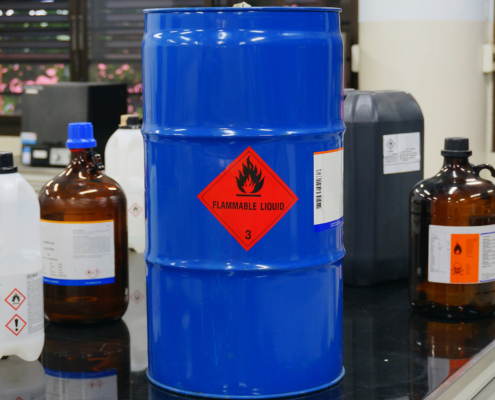
Why Does the Agriculture Industry Use Marker Flags?
Farmers and producers use marker flags to signify different plots of land, track property lines, what’s growing where, and what fertilizers and herbicides producers applied to various crops. They can also display the location of underground utilities, drainage tiles, and irrigation channels.
What Are the Agricultural Purposes of Marker Flags?
Many industries use marker flags to identify, isolate, and signify specific areas. For example, construction workers use marker flags to signify underground cables, drainage systems, and hazardous areas on the jobsite. The agriculture and farming industry uses marker flags similarly.
These ag marker flags are ideal for identifying property lines, crops, underground utilities, and irrigation and drainage points. These flags make the lives of ag producers easier because they have a physical, colored indicator of their property and what’s inside it. They also warn neighboring properties and outsiders of your property’s specificities.
Here are some essential uses of marking flags:
Property Lines
Identifying property lines is essential on farms and agricultural property. A plot of land is a substantial investment filled with crops, machinery, and other valuable assets. You need to secure and identify your field, so neighboring producers and unwanted intruders know where your property is to understand if they’re breaking the law.
Crops
Marking flags can signify what crops are growing in a designated field. A physical, easy reminder can prevent mistakes and helps producers identify crops during early seasons. Corn, wheat, cotton, and soybeans require different care and react differently to certain fertilizers and herbicides. Marking flags are an extra layer of protection to ensure everyone knows what land plots contain specific crops.
Field Technology
Field marking flags can identify the technology of produce— fertilizer and herbicide resistance. New technologies allow crops to resist and tolerate particular herbicides that would typically harm them. These technologies protect crops from external threats such as invasive pests and diseases.
However, even though certain herbicides can benefit crops, they can be harmful to others. Marking flags designate which herbicides and fertilizers producers can use on which crops, ensuring there are no accidental applications or careless applications from neighboring properties.
Underground Utilities
Like any other residential or commercial property, ag property has underground utilities for its daily operations. Power lines, irrigation systems, and other cables intersect through the property. Marker flags help identify these hidden underground utilities so machine operators don’t accidentally dig them up or disrupt them. Maintenance specialists and utility workers can also find them easier if marked.
Irrigation and Drainage
Like any other residential or commercial property, ag property has underground utilities for its daily operations. Power lines, irrigation systems, and other cables intersect through the property. Marker flags help identify these hidden underground utilities so machine operators don’t accidentally dig them up or disrupt them. Maintenance specialists and utility workers can also find them easier if marked.
Utility Marking Flags
Utility flags and stake flags come in varieties of different color flags, heights, and materials. They strive to be highly visible and easily identified for their purpose.
The “Flag the Technology” program is a newer agricultural system to help producers identify fields that are safe for herbicide application and those to avoid unintentional damage to adjacent crops. Producers place colored marking flags at entry points on lots, and each flag color represents a different kind of infused technology. These marking flags make herbicide applicators aware of which products are appropriate and safe to use in a specific field.
Here are a brief explanation of “Flag the Technology” utility marker flag colors:
Red
Red flags signify crops and produce with no herbicide resistance or traits. These could be organic plants or crops that have no current herbicide technology. It’s essential to protect red-flagged crops from the accidental application of herbicide. Neighboring farms can see these flags to consider wind before applying their herbicides.
Yellow
Bright yellow marker flags signify produce infused with Clearfield® Rice technology and STS® soybeans, and their specific herbicide specifications.
Teal
Teal marker flags indicate crops with tolerance to 2, 4D, and FOP (Accase) herbicides or the Enlist® technology. White stripes signify a tolerance to glyphosate-based herbicides.
Black and White Checkered
Black and white checkered flags signify a tolerance to dicamba herbicide or Xtend®. The black and white checks indicate tolerance to both dicamba and glyphosate.
White
White marking flags display that a crop implements Roundup® Ready technology and is resistant to glyphosate-based herbicides.
Green
Lastly, green marking flags indicate Liberty Link® technology. Crops labeled with bright green flags are tolerant to glufosinate-based herbicides.
Are you in need of personalized land marking flags? Axiom Products offers a variety of high-quality land marking flags in different measurements to meet your specific requirements.
Enhancing Work and Avoiding Mistakes
One of the leading purposes of marker flags is to help producers accomplish their job easier while preventing avoidable mistakes. Marking flags let producers and their employees quickly know their plots, what’s in them, and what chemicals to use on them, avoiding preventable mistakes in their day-to-day processes.
Axiom Products Creates Personalized Marking Flags
Does your farm need marking flags? Look no further than Axiom Products.
Axiom Products can create printed marking flags and AG marking products to be personalized with customizable marking flags for your brand or company. They are made from premium materials for heavy-duty applications and built to endure harsh outdoor environments. They come in various colors at 5-foot or 8-foot heights for easy visibility and additional reflective strips of orange, blue, or yellow. These flags don’t come from your local store or Home Depot.
Whether for ag property evaluation, excavation projects, lawn and turf services, or scientific research, Axiom Products is the supplier for you.






